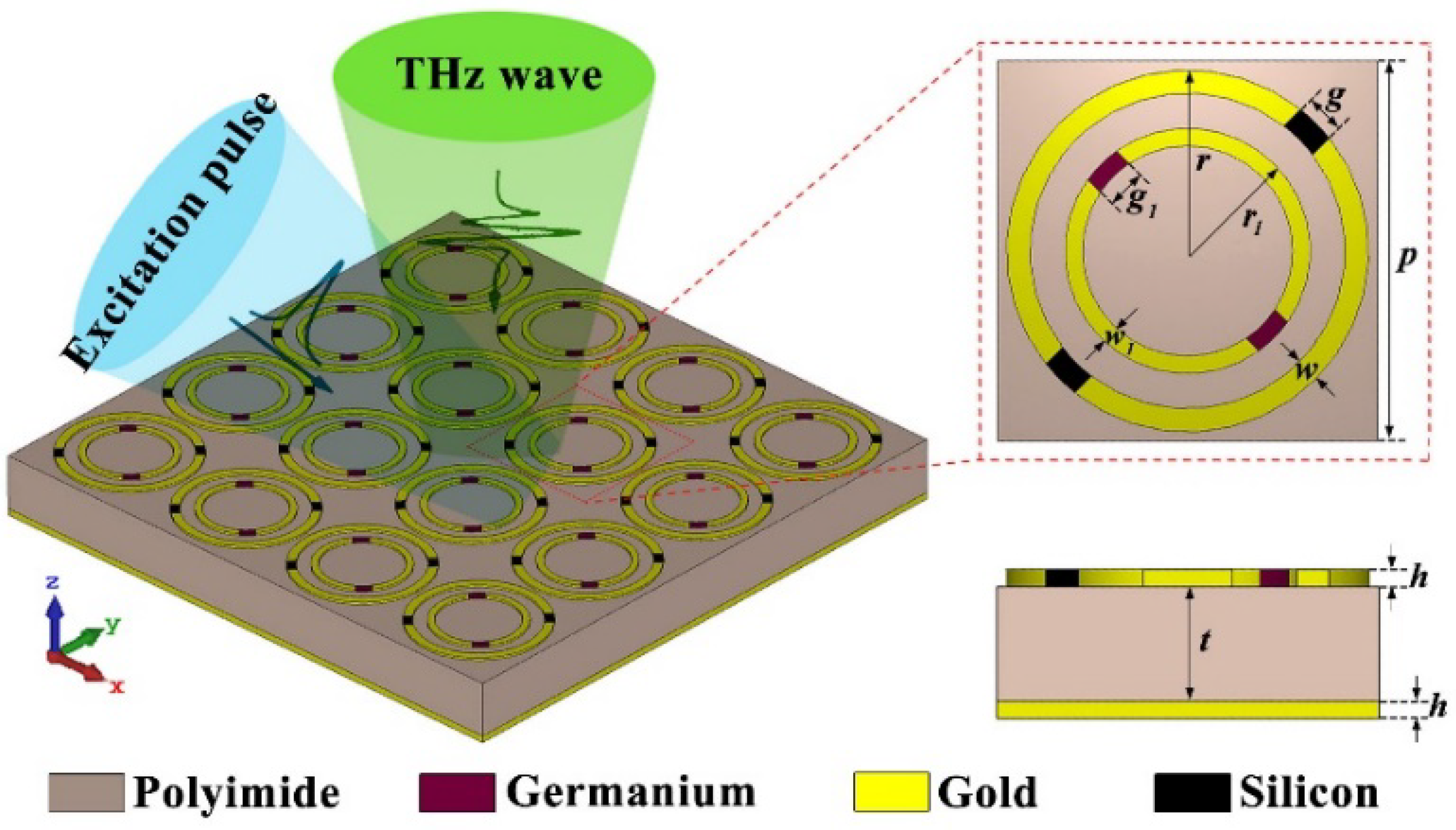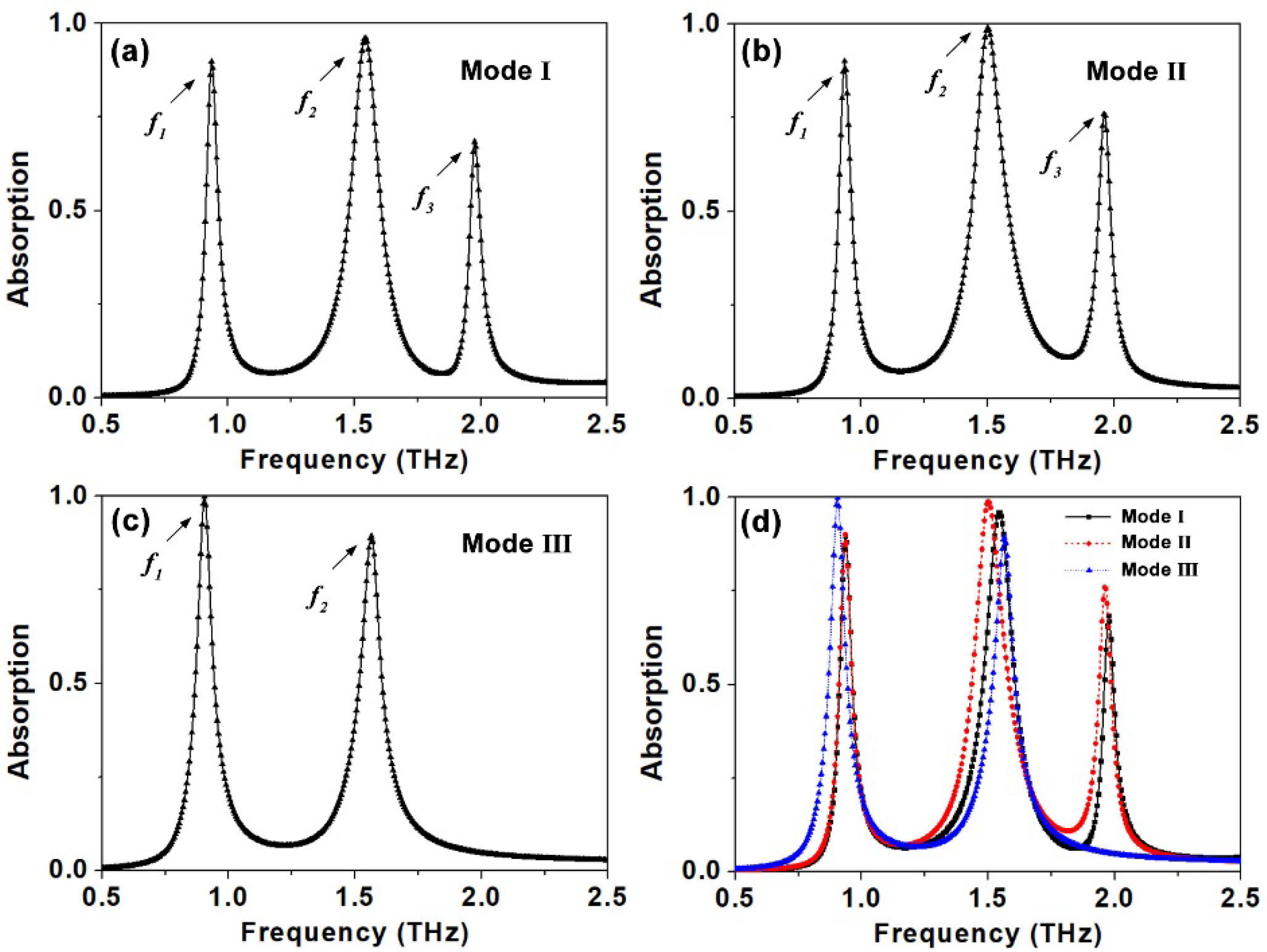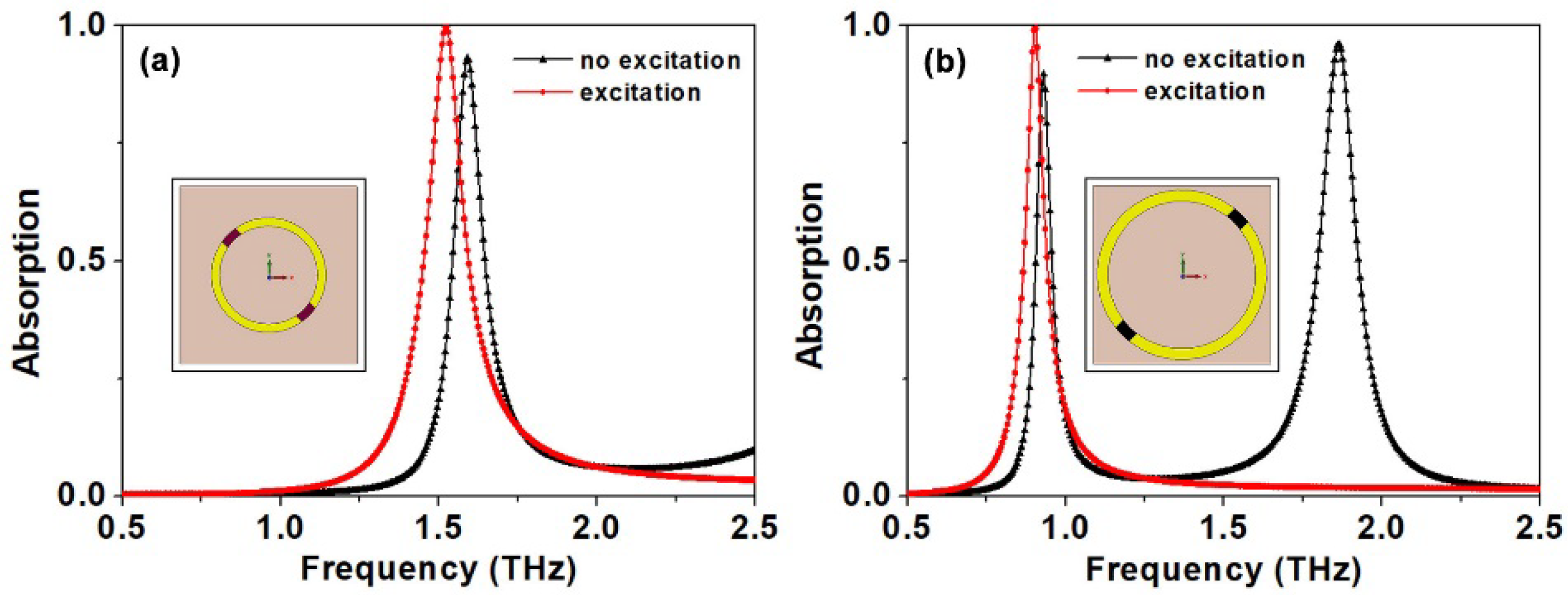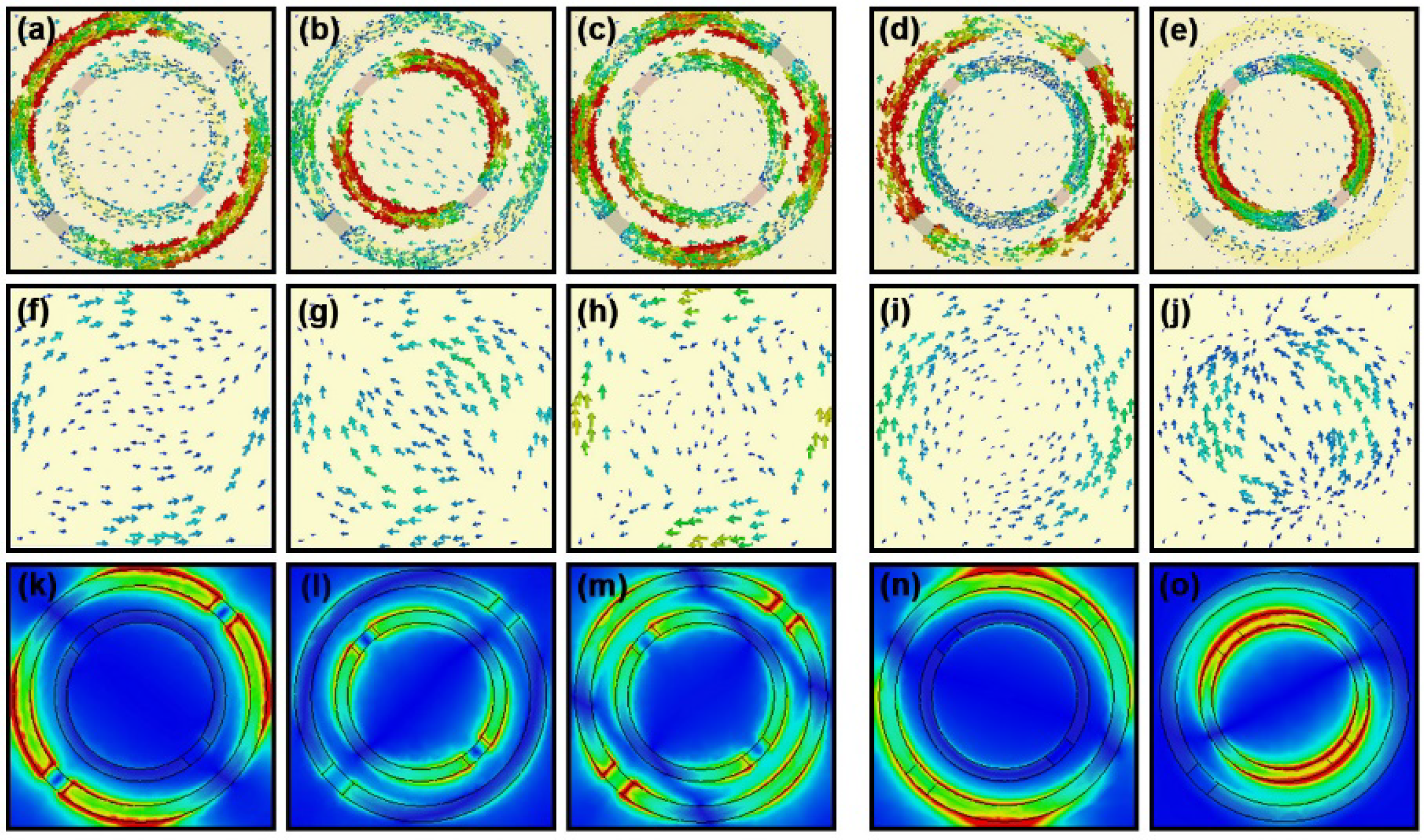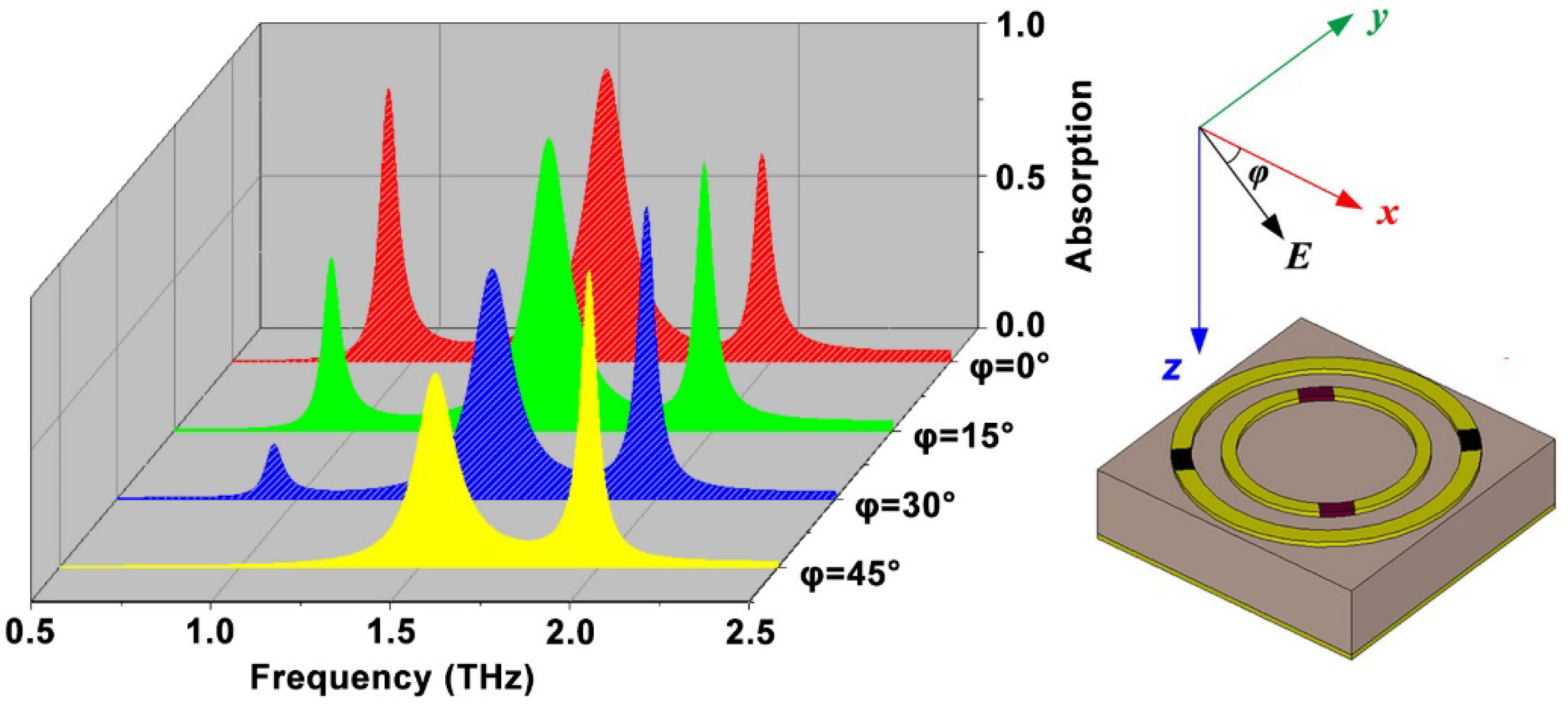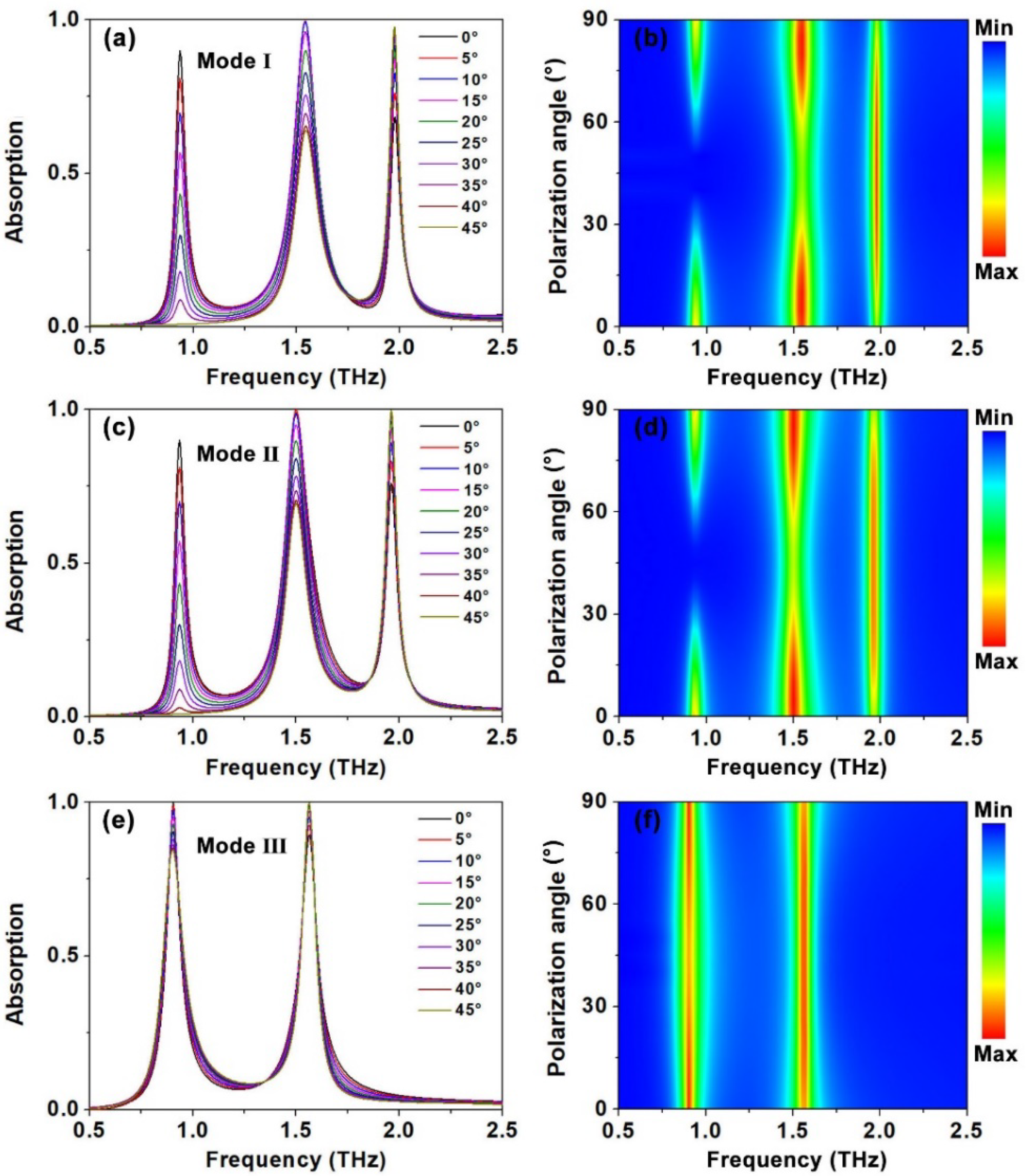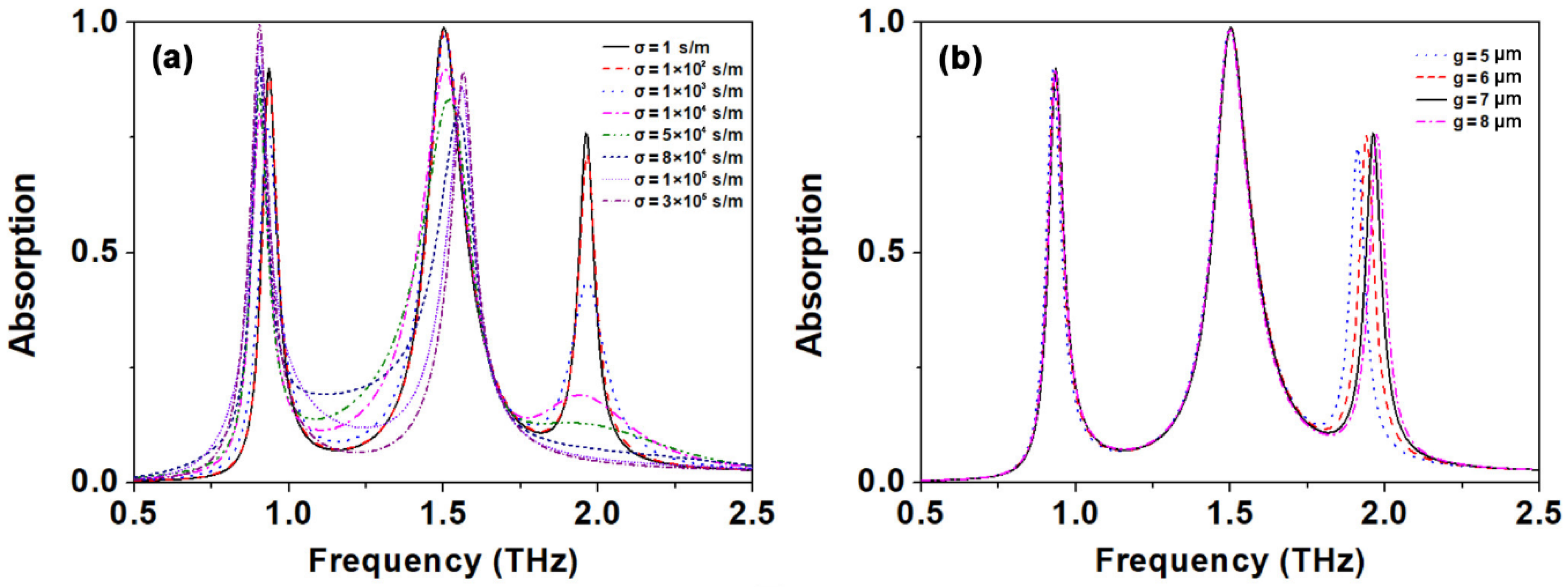1. Introduction
Metamaterial is an artificially synthesized electromagnetic material with periodic structure. Metamaterial devices attract significant global interest due to their strong responses to terahertz (THz) waves [
1,
2,
3,
4,
5]. Since the first metamaterial perfect absorber was proposed by Landy in 2008 [
6], many devices have been explored, including absorbers, switches, filters, and converters [
7,
8,
9,
10]. In recent years, significant research progress has been made regarding THz metamaterial absorbers [
11,
12,
13]; absorption modes expanded from single-band to multi-band, and the operating range gradually expanded to cover microwave, terahertz, and infrared frequency ranges, as well as visible light regions.
Traditional THz metamaterial absorbers are passive and inconvenient; once the structure is fixed, absorption performance cannot be changed. To solve this problem, dynamically tunable terahertz metamaterial absorbers integrating with active materials have been widely designed and explored. Nowadays, various types of functional materials are introduced into the structure, and multiple excitation methods are utilized to change absorption performance [
14,
15,
16]. H. Jeong et al. proposed a thermal frequency reconfigurable electromagnetic absorber using germanium telluride phase-change material [
17]. M.A. Baqir et al. obtained a nanostructured hyperbolic metamaterial (HMM)-based absorber in the entire ultraviolet regime [
18]. S. Yuan et al. obtained a photoexcited single-/dual-band switchable terahertz metamaterial absorber excited by laser by introducing photosensitive silicon into the structure. [
19]. S. H. Raad et al. proposed a bi-functional tunable device composed of graphene-coated cylindrical wires and VO
2. The metal–insulator transition in phase-change material makes it feasible to switch between reflector and absorber [
20]. T. L. Wang et al. obtained a dual-controlled switchable broadband terahertz metamaterial absorber based on a hybrid of vanadium dioxide and graphene. Changing the Fermi energy of the graphene and adjusting the conductivity of the vanadium dioxide allowed the peak absorption modulation to be realized [
21]. R. M. H. Bilal et al. presented a metamaterial absorber that consists of fractal geometry of Pythagorean-tree in the THz region [
22]. M. Pan et al. proposed a triple-band perfect absorber based on graphene with silicon as the substrate; by changing the gate voltage, dynamic control of the absorption characteristics was realized [
23]. J. Zhu et al. obtained a wide band absorber with adjustable bandwidth composed of a graphene rectangular ring and graphene strip cross structures [
24].
Although progress has been made, urgent problems, such as modulation depth deficiency, the lack of multiparameter-tunable characteristics, and so on, remain to be solved. In this paper, we propose a multiparameter-tunable terahertz absorber composed of two concentric double-opening resonant rings. Semiconductor silicon and germanium are introduced to fill the openings, so that the absorber possesses three different absorption modes. Regulating the semiconductor conductivities using different pump lasers allows dynamic switching among the three absorption modes. Adjusting the polarization angle of incident THz waves through device rotation facilitates easy and convenient modulation of the absorption amplitude. Calculation results show that the maximum modulation range for amplitude is 0 to 90.1%. Thus, due to the existence of two regulatory degrees of freedom, different absorption modes switching and amplitude modulation are realized simultaneously. Most importantly, continuous modulation of the absorption amplitude is obtained at every resonant point in all three absorption modes without frequency drift, which is the excellent performance that we expect.
2. Materials and Methods
As shown in
Figure 1, the proposed structure consists of three layers. From top to bottom, these are the patterned Au layer, polyimide layer, and fully reflective layer. The patterned Au layer consists of two concentric double-opening resonant rings with different radii. The fully reflective layer is also formed of Au, with conductivity σ = 4.5 × 10
7 S/m. Silicon fills the double-openings of the outer ring; its relative dielectric constant is ε
Si = 11.7. Germanium fills the double-openings of the inner ring; its relative dielectric constant is ε
Ge = 16.3. Polyimide is utilized to fabricate the intermediate layer; its relative dielectric constant is ε
r = 3.5. The optimized geometrical parameters of the unit cell are as follows: p = 65 μm, r = 31 μm, r
1 = 18 μm, ω = 4 μm, ω
1 = 3 μm, g = 7 μm, g
1 = 7 μm, h = 0.6 μm, and t = 6 μm. Design and simulation were carried out in the CST Microwave Studio. Absorption spectra were extracted using the frequency domain solver. The initial boundaries along
x-direction and
y-direction are magnetic field and electric field, respectively. The incident THz wave propagates along the negative z direction. The angle between the direction of polarization electric field and
x-direction is marked as φ. It is well known that the conductivities of silicon and germanium can be regulated and controlled using excitation lights [
25,
26]. Germanium can be excited using a 1550 nm laser; both silicon and germanium can be excited using an 800 nm laser. Without an excitation pulse, their conductivities are taken to be σ = 1 S/m. When excited by being pumped by a laser, σ can be calculated as σ = 3 × 10
5 S/m [
27,
28]. Changes in φ or σ affect absorption characteristics, which is the primary reason dynamic tuning can be achieved.
The absorption of absorbers can be calculated using the formula A(ω) = 1 − T(ω) − R(ω). Here, A(ω) represents absorption, T(ω) = |S21|2 represents transmission, and R(ω) = |S11|2 refers to reflection. Both S11 and S21 are scattering parameters that can be directly obtained from the numerical simulation results. In the 0.5 THz–2.5 THz frequency range, the skin depth value of gold is calculated to be between 0.047 μm and 0.106 μm, which is much smaller than the thickness of the fully reflective layer. Therefore, overall absorption can be expressed as A(ω) = 1 − R(ω), because T(ω) is calculated as zero.
3. Results and Discussion
Absorption spectra under different conditions are depicted in
Figure 2. Without excitation, there were three separate absorption peaks, as seen in
Figure 2a. For clarity, the peak at 0.935 THz with a corresponding absorption amplitude of 89.8% is marked as peak
f1, the peak at 1.545 THz with a corresponding absorption amplitude of 96.1% is marked as peak
f2, and the peak at 1.975 THz with a corresponding absorption amplitude of 68.4% is marked as peak
f3. According to the definition, full-width at half-maximum (FWHM) are 0.055 THz for peak
f1, 0.135 THz for peak
f2, and 0.055 THz for peak
f3. We called this absorbing state Mode I. Germanium was excited using a 1550 nm laser. Although three separate absorption peaks still existed, the absorption spectrum changed. As shown in
Figure 2b, the resonant frequency and absorption amplitude of both peak
f2 and peak
f3 changed, but did not change for peak
f1. Peak
f2 experienced a red shift, and its resonant frequency switched from 1.545 THz to 1.500 THz. Similarly, peak
f3 also experienced a red shift, and its resonant frequency switched from 1.975 THz to 1.960 THz. The absorption amplitudes of peaks
f2 and
f3 increased to 98.9% and 76.0%, respectively. FWHMs for peaks
f1,
f2, and
f3 were 0.060 THz, 0.140 THz, and 0.065 THz, respectively. We called this absorbing state Mode II. Both germanium and silicon were excited using an 800 nm laser; there were only two separate absorption peaks, as seen in
Figure 2c. Compared with Mode II, peak
f1 experienced a red shift, and the resonant frequency switched from 0.935 THz to 0.905 THz. Peak
f2 experienced a blue shift, and the resonant frequency switched from 1.500 THz to 1.565 THz. Meanwhile, the absorption amplitudes of peak
f1 and peak
f2 increased to 99.9% and 89.3%, respectively. FWHMs for peaks
f1 and
f2 were 0.085 THz and 0.100 THz, respectively. We called this absorbing state Mode III. A comparison of the absorption spectra under different conditions is provided in
Figure 2d. It can be concluded that the main reason for dynamic switches in the resonant frequency was the structure change caused by the excitation pulse of the proposed MMA. Illumination induced increased carrier concentration, which led to variations in material properties.
To better understand the absorber’s resonance mechanism, two independent concentric rings were studied separately.
Figure 3a shows the absorption spectrum of the inner resonant ring. Only one resonant peak with an absorption amplitude of 93.2% was found at 0.590 THz without excitation, as well as one with an absorption amplitude of 99.8% at 1.520 THz with excitation. The absorption spectrum of the outer resonant ring is depicted in
Figure 3b. Without excitation, two separated absorption peaks were found, at 0.930 THz and 1.865 THz, with absorption amplitudes of 89.7% and 96.0%, respectively; with excitation, there was only one resonant peak at 0.905 THz with an absorption amplitude of 99.4%. It can be concluded that three absorption peaks were created by the superposition of the two independent concentric resonant rings. The weak coupling of the two resonant rings induced a small drift in resonant frequency and a decrease in amplitude.
To better reveal the physical mechanism of the absorption peaks, surface currents and electric fields at the resonance points of Mode I and Mode III were also investigated. For Mode I, as shown in
Figure 4a, currents were symmetrically distributed on both sides of the outer double-opening resonant ring. It is a typical characteristic that peak
f1 was caused by electric dipole resonance, which was confirmed by the electric field distribution depicted in
Figure 4k. Similar to peak
f1, peak
f2 was caused by electric dipole resonance generated by the inner double-opening resonant ring. However, the distributions of surface currents and electric fields of peak
f3 were different from those of peak
f1 and peak
f2, as shown in
Figure 4e. Surface current was divided into four parts evenly distributed around the circumference of the outer double-opening resonant ring. This indicates that the main cause of peak
f3 was quadrupole resonance. For Mode III, as shown in
Figure 4d–e,n–o, the physical mechanism of absorption peaks
f1 and
f2 were almost the same as Mode I. However, peak
f3 disappeared. This may have been caused by the missing coupling resonance generated by the superposition of the two split rings when germanium and silicon were excited at the same time.
Figure 4f–j present surface currents on the metal ground plate, which were opposite to that of the top surface, indicating corresponding magnetic resonance. Therefore, two resonant modes enabled triple-band absorption in our interesting frequency range by strongly constraining and depleting the incident electromagnetic energy.
Subsequently, we studied the dynamic regulation of absorption amplitudes using different polarization angles. As previously mentioned, the angle between the direction of the polarization electric field and
x-direction is marked φ. Four typical polarization angles, 0°, 15°, 30°, and 45°, were selected. Absorption spectra are depicted in
Figure 5. Corresponding to different polarization angles, the absorption amplitudes of the three peaks varied. This indicates that polarization angles of the incident THz wave can be used as a regulatory degree of freedom to control absorption characteristics. More importantly, the resonance frequencies remained constant as the absorption amplitude changed. In other words, the modulation of absorption amplitudes can be realized at fixed resonant points without frequency drift, which is the unique performance that we expected.
For further study, a 5° polarization angle change was set as the step size. Absorption spectra were recorded in sequence, corresponding to different polarization angles. Before discussing this further, an important parameter must be introduced: modulation depth is defined as
D = (Amax −
Amin)/Amax, where
Amax is the maximum value of the absorption amplitude and
Amin is the minimum value at resonant frequency.
Figure 6a,b show changing conditions while the absorber operated in Mode I. As
φ increased from 0° to 45°, the absorption amplitude of peak
f1 decreased from 89.8% to 0, and the absorption amplitude of peak
f2 decreased from 99.6% to 63.9%. In contrast, the absorption amplitude of peak
f3 increased from 68.4% to 97.7%. As
φ increased from 45° to 90°, an inverse change process began, due to the symmetric structure of the proposed absorber. According to the definition, amplitude modulation depths for peaks
f1,
f2, and
f3 are 100%, 36%, and 30%, respectively.
Figure 6c,d show changing conditions in Mode II. As
φ increased from 0° to 45°, the absorption amplitude of peak
f1 decreased from 90.1% to 0, and the absorption amplitude of peak
f2 decreased from 99.8% to 69.4%. The absorption amplitude of peak
f3 increased from 75.9% to 99.8%. As
φ increased from 45° to 90°, another inverse change process began. Similarly, amplitude modulation depths for peaks
f1,
f2, and
f3 are 100%, 30%, and 24%, respectively.
Figure 6e,f show changing conditions in Mode III. As
φ increased from 0° to 45°, the absorption amplitude of peak
f1 decreased from 99.8% to 84.6%, and that of peak
f2 increased from 89.3% to 99.7%. As
φ increased from 45° to 90°, another inverse change process began. Amplitude modulation depths for peaks
f1 and
f2 were 15% and 10%, respectively. Given the above evidence, we can conclude that changing the polarization angle will not break the original resonant mode or generate new resonance; it does affect the strength of the resonance intensity, which is an effective way to realize amplitude modulation. In contrast, a significant variation in absorption was evident under the effect of the pumping laser. As shown in
Figure 6d,f, peak
f1 disappeared when the 800 nm laser was used instead of the 1550 nm laser. As germanium and silicon were excited at the same time, both the inner and outer rings were operational, the inherent resonant mode was broken, and the coupling resonance generated by the superposition of the two split rings disappeared. Therefore, pumping filling materials with different laser wavelengths changed the device’s structure, which was the primary reason the absorption modes switched.
Finally, the absorption spectra using different silicon conductivities and the effect of gap size on the absorption spectrum were studied. As shown in
Figure 7a, as silicon conductivities gradually increased, the absorption amplitude of all three peaks changed. Resonant frequency drift was also associated with these changes, especially for peak
f3; when silicon conductivity was 1 × 10
5 S/m, peak
f3’s resonant absorption almost completely disappeared. The whole absorption spectrum seemed more perfect when the value was 3 × 10
5 S/m. Therefore, another 100% modulation depth of absorption amplitude was obtained. The effect of gap size on the absorption spectrum is depicted in
Figure 7b. As
g gradually increased from 5 μm to 8 μm, absorption peak
f1 experienced a slight red shift and peak
f3 experienced an evident red shift. Calculation results are entirely consistent with the previous analysis regarding the resonance formation mechanism previously discussed.
